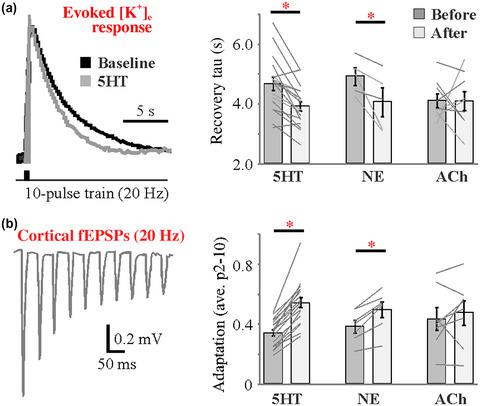当前位置:
X-MOL 学术
›
J. Neurosci. Res.
›
论文详情
Our official English website, www.x-mol.net, welcomes your feedback! (Note: you will need to create a separate account there.)
Serotonin, norepinephrine, and acetylcholine differentially affect astrocytic potassium clearance to modulate somatosensory signaling in male mice.
Journal of Neuroscience Research ( IF 4.2 ) Pub Date : 2020-02-17 , DOI: 10.1002/jnr.24597 Caitlin A Wotton 1 , Cassidy D Cross 1 , Lane K Bekar 1
Journal of Neuroscience Research ( IF 4.2 ) Pub Date : 2020-02-17 , DOI: 10.1002/jnr.24597 Caitlin A Wotton 1 , Cassidy D Cross 1 , Lane K Bekar 1
Affiliation

|
Changes in extracellular potassium ([K+ ]e ) modulate neuronal networks via changes in membrane potential, voltage-gated channel activity, and alteration to transmission at the synapse. Given the limited extracellular space in the central nervous system, potassium clearance is crucial. As activity-induced potassium transients are rapidly managed by astrocytic Kir4.1 and astrocyte-specific Na+ /K+ -ATPase, any neurotransmitter/neuromodulator that can regulate their function may have indirect influence on network activity. Neuromodulators differentially affect cortical/thalamic networks to align sensory processing with differing behavioral states. Given serotonin (5HT), norepinephrine (NE), and acetylcholine (ACh) differentially affect spike frequency adaptation and signal fidelity ("signal-to-noise") in somatosensory cortex, we hypothesize that [K+ ]e may be differentially regulated by the different neuromodulators to exert their individual effects on network function. This study aimed to compare effects of individually applied 5HT, NE, and ACh on regulating [K+ ]e in connection to effects on cortical-evoked response amplitude and adaptation in male mice. Using extracellular field and K+ ion-selective recordings of somatosensory stimulation, we found that differential effects of 5HT, NE, and ACh on [K+ ]e regulation mirrored differential effects on amplitude and adaptation. 5HT effects on transient K+ recovery, adaptation, and field post-synaptic potential amplitude were disrupted by barium (200 µM), whereas NE and ACh effects were disrupted by ouabain (1 µM) or iodoacetate (100 µM). Considering the impact [K+ ]e can have on many network functions; it seems highly efficient that neuromodulators regulate [K+ ]e to exert their many effects. This study provides functional significance for astrocyte-mediated buffering of [K+ ]e in neuromodulator-mediated shaping of cortical network activity.
中文翻译:

5-羟色胺,去甲肾上腺素和乙酰胆碱可差异地影响星形细胞钾清除,从而调节雄性小鼠的体感信号传导。
细胞外钾([K +] e)的变化通过膜电位,电压门控通道活性以及突触传递的改变来调节神经网络。鉴于中枢神经系统的细胞外空间有限,钾清除至关重要。由于星形胶质细胞Kir4.1和星形胶质细胞特异性Na + / K + -ATPase可迅速控制活动诱导的钾离子瞬变,因此任何可调节其功能的神经递质/神经调节剂都可能对网络活动产生间接影响。神经调节剂差异地影响皮层/丘脑网络,以使感觉处理与不同的行为状态保持一致。考虑到5-羟色胺(5HT),去甲肾上腺素(NE)和乙酰胆碱(ACh)会不同地影响体感皮层中的尖峰频率适应性和信号保真度(“信号噪声”),我们假设[K +] e可能受到不同神经调节剂的差异调节,从而对网络功能发挥各自的作用。这项研究旨在比较单独施用5HT,NE和ACh对调节[K +] e的影响,以及对雄性小鼠皮层诱发反应幅度和适应性的影响。使用体感刺激的细胞外场和K +离子选择性记录,我们发现5HT,NE和ACh对[K +] e调节的差异作用反映了幅度和适应性的差异作用。钡(200 µM)破坏了5HT对瞬时K +恢复,适应和突触后场电位振幅的影响,而哇巴因(1 µM)或碘乙酸盐(100 µM)破坏了NE和ACh的影响。考虑到[K +] e对许多网络功能的影响;神经调节剂调节[K +] e发挥许多作用似乎非常有效。这项研究为星形胶质细胞介导的[K +] e在神经调节剂介导的皮层网络活性塑造中提供功能性意义。
更新日期:2020-02-17
中文翻译:

5-羟色胺,去甲肾上腺素和乙酰胆碱可差异地影响星形细胞钾清除,从而调节雄性小鼠的体感信号传导。
细胞外钾([K +] e)的变化通过膜电位,电压门控通道活性以及突触传递的改变来调节神经网络。鉴于中枢神经系统的细胞外空间有限,钾清除至关重要。由于星形胶质细胞Kir4.1和星形胶质细胞特异性Na + / K + -ATPase可迅速控制活动诱导的钾离子瞬变,因此任何可调节其功能的神经递质/神经调节剂都可能对网络活动产生间接影响。神经调节剂差异地影响皮层/丘脑网络,以使感觉处理与不同的行为状态保持一致。考虑到5-羟色胺(5HT),去甲肾上腺素(NE)和乙酰胆碱(ACh)会不同地影响体感皮层中的尖峰频率适应性和信号保真度(“信号噪声”),我们假设[K +] e可能受到不同神经调节剂的差异调节,从而对网络功能发挥各自的作用。这项研究旨在比较单独施用5HT,NE和ACh对调节[K +] e的影响,以及对雄性小鼠皮层诱发反应幅度和适应性的影响。使用体感刺激的细胞外场和K +离子选择性记录,我们发现5HT,NE和ACh对[K +] e调节的差异作用反映了幅度和适应性的差异作用。钡(200 µM)破坏了5HT对瞬时K +恢复,适应和突触后场电位振幅的影响,而哇巴因(1 µM)或碘乙酸盐(100 µM)破坏了NE和ACh的影响。考虑到[K +] e对许多网络功能的影响;神经调节剂调节[K +] e发挥许多作用似乎非常有效。这项研究为星形胶质细胞介导的[K +] e在神经调节剂介导的皮层网络活性塑造中提供功能性意义。


























 京公网安备 11010802027423号
京公网安备 11010802027423号